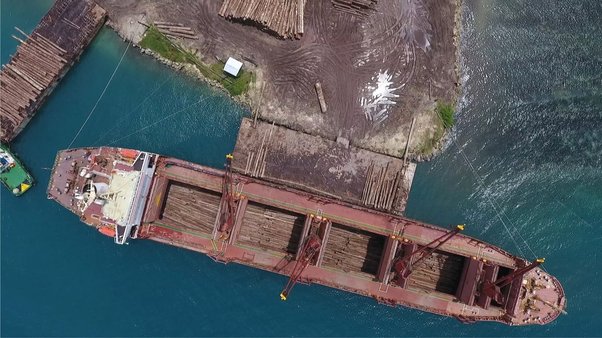As consumer and industry demand increases, China’s timber imports have grown rapidly in recent years. The country now relies on imports for over half of its timber. But many of the countries it is sourcing that timber from – including a huge 80% of its suppliers of tropical timber – are linked to high levels of illegal logging and deforestation. This kind of destruction has a devastating impact on forests, biodiversity, climate and local communities around the world.
One thing is clear: Chinese firms have not been paying sufficient attention to whether the imported timber they buy and process is actually legal.
The very welcome and newly revised Forest Law brings hope that this problem could be tackled. If effectively implemented, these amendments may well reduce illegal timber imports into the Chinese market.
The revision of the Forest Law came into effect on 1 July, 2020, and for the first time provides a legal basis for tackling the illegal timber trade.
However, rules on the implementation of the law – the Regulations for Implementing the Forest Law – have not yet been issued, and it remains unclear how the law will be applied to stop illegal timber imports.
The Chinese government announced in June that the Regulations are included in its 2020 plans for legislative work. Here we offer some reflections on the measures needed to ensure it is effective.
First, we recommend the Regulations make clear that companies are responsible for environmental and legal risks in their timber supply chains, and that those companies have a duty to carry out due diligence.
How should this duty be fulfilled?
We think companies should actively examine their supply chains to assess whether their timber may be coming from illegal sources or illegally transported or traded, and then take measures to mitigate this risk.
For example, when sourcing or trading timber from very high-risk regions, the widespread prevalence of illegal logging there (which can even include the illegal issuance of logging permits by officials) means local official documents or third party certification of legality cannot guarantee legality.
Companies must therefore actively seek to understand the risks associated with its suppliers – and the country that it sources timber from – to avoid purchasing timber that is at high risk of illegality.
Secondly, the Regulations should set out mandatory requirements for companies to use ledgers as a tool to manage timber legality risks.
Article 65 of the Forest Law requires companies to maintain a record of the movement of raw materials, in ledgers, to provide traceability and avoid supply chain legality risks.
For imported timber, we recommend the Regulations specify the information companies should record, including the scientific name of the timber, value, quantity and source country – and more importantly, measures taken to identify, avoid and mitigate potential legality risks.
By doing so, the companies would also be keeping a record of how they are carrying out due diligence.
China has already successfully applied this record-keeping approach elsewhere.
Rules issued by the State Council to strengthen oversight and management of food safety, and to control the emission of pollutants, have required companies to maintain such records.
The Ministry of Ecology and Environment has produced a technical standard for record keeping of environment management.
We believe both authorities and businesses have acquired valuable experience of the role of record keeping in traceability, safety and promoting environmental governance.
It’s crucial to note: due diligence on timber legality risks are in the own interests of a company.
Company records can form the basis of systems and processes to identify and manage supply chain risks, to avoid potential material and reputational costs.
For China’s own exporters, this will help meet legality requirements of their target markets, such as the EU Timber Regulation or the US Lacey Act.
Whilst China has a relatively sophisticated regulatory framework to manage the production and trade of its domestic timber, it has yet to announce measures to ensure the legality of timber imports.
We therefore believe imported timber represents the biggest risks for Chinese companies who have committed to ensuring timber legality.
- Address risk associated with imported timber: First, the Regulations should specifically address importers and companies using imported timber. Timber importers, which generally have a better understanding of the situation in the source country, should bear a particular responsibility for the legality of their imports. If they can identify and reduce legality risks, and maintain records of these, this will help downstream processors and exporters understand and manage their own legality risks and comply with the law.
- Address risk associated with tropical timber: Second, the Regulations should require particularly rigorous identification and mitigation of legality risks by companies importing and using tropical timber. Our research has found illegal logging widespread in top ten countries which supply 80% of China’s tropical log imports. Several studies have found that 70% of tropical log exports from China’s biggest supplier, Papua New Guinea, may come from illegal sources. China’s second biggest supplier, the Solomon Islands, exports more than 19 times its annual sustainable harvest. Approximately half of China’s tropical logs come from these two countries. Illegal logging’s impact goes beyond environmental destruction of climate critical forests, it also threatens local livelihoods and development.
Last but not the least, we offer two further recommendations to ensure effective implementation and enforcement of the law.
The Regulations should designate government agencies to carry out regular inspection of company’s compliance – to ensure accurate record-keeping and stringent risk management.
The Regulations should create a single national electronic platform for timber ledgers, where companies regularly upload and update information, for regular spot checks by law enforcement bodies.
The authorities should also require companies facing higher risks to publish reports on how they are mitigating timber legality risks.
This will help ensure accountability and reduce the burden for law enforcement bodies.
We hope these recommendations will be taken into account, and that the Regulations will ensure the effective implementation of the new Forest Law – and finally help China tackle the trade in illegal timber.
By doing so, the government can be sure it is not contributing to the destruction of climate critical forests crucial for biodiversity and sustainable development.
Read this page in



